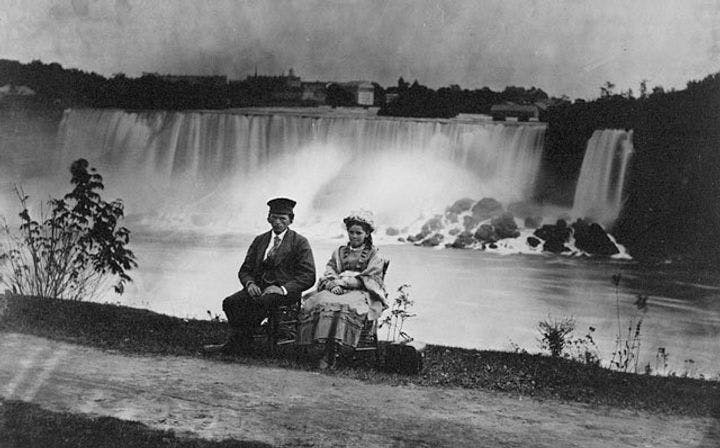Summer 2008
Over in a Barrel
– Eric Hand
Eric Hand on the history of Niagara Falls
It sounds like a naturalized urban legend, but the rumor holds water: Niagara Falls is turned up for the tourists. At night, and during the off-season, much of its flow is diverted into turbines for peak power generation. When Ginger Strand, an environmental writer from New York City, discovered this fact while taking notes on a foray to the falls, she “stopped scribbling and just grinned like a maniacal toddler.” It is the starting point for Inventing Niagara, a picaresque journey that explains how just about everything at Niagara Falls is engineered, Disneyfied, or deluded.
The 176-foot drop in the Niagara River between Lakes Erie and Ontario, on the border between Ontario and New York, is neither the largest nor the tallest cataract in the world. But it does occupy an outsized place in American mythology, sitting at the frontier of a young country just venturing into tourism. As Strand sees it, that virginal experience went horribly awry. Goat Island, a wooded hunk of rock in the middle of the river, became a staging area for parking lots. The Cave of the Winds, a natural cave behind the falls, was blasted away to make room for an eponymous observation deck. The history of the place has been bowdlerized; the waste from falls-powered industries, buried. Taken together, these stories say a lot about America’s relationship with nature, Strand argues, and so she sets herself to rescuing the true Niagara from the memory hole.
The Native Americans who once lived in the region avoided the falls, with its rattlesnakes and dangerous river rapids. When Europeans arrived in the 17th century, they immediately set to dispossessing the local tribes. The patron saint of Niagara Falls, a city on the New York side of the river, was a 19th-century landowner named Peter Porter lauded for his purported proto-environmental views, but Strand discovers that he was more interested in war profiteering and land grabs than in philanthropy. She moves on to the history of the tacky museums, with their Egyptian mummies and two-legged dogs, and the falls’ use as a backdrop to acts of daredevilry. No diversion or digression is too small. While she sketches each tale with humor, the kaleidoscopic narrative at times resembles one of the tawdry casinos around the falls that she deplores—lots of bright lights, jingling and jangling, but ultimately a place to satisfy a compulsion.
Yet it is hard to begrudge Strand her indulgences. Her prose is cheeky and sharp. In two sentences, she limns the early life of Frederick Law Olmsted: “He went to sea and almost died of scurvy. He bought a farm and won a prize for pears.” Olmsted, the architect of New York’s Central Park, pushed in the 1870s to make Niagara a place of wooded paths for all classes of society to enjoy—though Strand faults him for being patriarchal and elitist. With good reason, she is much harder on Robert Moses, another New York master planner, who, nearly a century later, ruthlessly paved the way (literally—the Robert Moses Parkway divides the Niagara River from nearby communities) for a power authority that spawned toxic waste–dumping industries.
The book’s most compelling chapter examines Niagara Falls as a symbol for sex. Strand mixes the history of the honeymoon capital—a tradition hastily evolved through heavy marketing—with ruminations on Marilyn Monroe (the falls, like Marilyn, have “been girdled and boosted into the shape the audience wants”). And she weaves in scenes from an in-town convention of the Red Hat Society, a club for women over 50 that revolves largely around merchandising and the slogan “Red Hatters Matter.” The parallels are incisive, even sadly profound.
Strand has produced a multilayered book that occasionally sparkles and shimmers. But after a point, keeping up with her tireless reportage becomes exhausting. Inventing Niagara may best be appreciated in dribbles, like Niagara Falls during the off-season.
* * *
Eric Hand is a science reporter for Nature.
Reviewed: "Inventing Niagara: Beauty, Power, and Lies" by Ginger Strand, Simon & Schuster, 2008.
Photo courtesy of Wikimedia Commons
